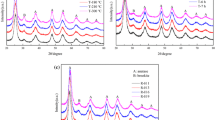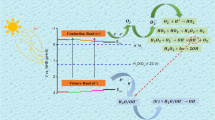Abstract
Thermal analysis (TA) techniques were applied in order to predict the influence of thermal treatment, on the photocatalytic performance of TiO2 materials prepared via sol–gel method in various temperatures between 250 and 600 °C in different alcohols (methanol/ethanol). Calorimetric results showed that the formation of TiO2 is faster in methanol than in ethanol. TA patterns showed that slight differences observed in the thermal behavior of the material can affect both its textural and photocatalytic properties. The appearance of the endothermic peaks in the area of 250–450 °C refer to crystallization of amorphous to crystalline phases or to the transformation of the less active rutile to the more active anatase phase. The results obtained from TG/DSC are in accordance to XRD results and SEM images. Thermal treatment affects the photocatalytic properties of the materials. Samples prepared in methanol showed better photocatalytic behavior than those in ethanol while the increase in temperature decreases the effectiveness of the materials.






Similar content being viewed by others
References
Barbe CJ, Arendse F, Comte P, Jirousek M, Gratzel M. Nanocrystalline titanium oxide electrodes for photovoltaic applications. J Am Ceram Soc. 1997;80:3157–71.
Monticone S, Tufeu R, Kanaev AV, Scolan E, Sanchez C. Quantum size effect in TiO2 nanoparticles: does it exist? Appl Surf Sci. 2000;162–163:565–70.
Boujday S, Wünsch F, Portes P, Bocquet JF, Colbeau-Justin C. Photocatalytic and electronic properties of TiO2 powders elaborated by sol–gel route and supercritical drying. Sol Energy Mater Sol Cells. 2004;83:421–33.
Carp O, Huisman CL, Reller A. Photoinduced reactivity of titanium dioxide. Prog Solid State Chem. 2004;32:133–77.
Ruiz AM, Sakai G, Cornet A, Shimanoe K, Morante JR, Yamazoe N. Microstructure control of thermally stable TiO2 obtained by hydrothermal process for gas sensors. Sens Actuators B Chem. 2004;103:312–7.
Wilson SC, Burnett V, Waterhouse KS, Jones KC. Volatile organic compounds in digested United Kingdom sewage sludge. Environ Sci Technol. 1994;28:259–66.
Ollis DF, Pelizzetti E, Serpone N. Photocatalyzed destruction of water contaminants. Environ Sci Technol. 1991;25:1522–9.
Ding Z, Lu GQ, Greenfield PF. Role of the crystallite phase of TiO2 in heterogeneous photocatalysis for phenol oxidation in water. J Phys Chem B. 2000;104:4815–20.
Wang YQ, Tang XH, Huang W, Yin Y, Hacohen R, Gedanken A. Sonochemical synthesis of mesoporous titanium oxide with wormhole like framework structures. Adv Mater. 2000;12:1183–6.
Pucher P, Benmami M, Azouani R, Krammer G, Chor K, Bocquet JF, Kanaev AV. Nano-TiO2 sols immobilized on porous silica as new efficient photocatalyst. Appl Catal A Gen. 2007;332:297–303.
Hoffmann MR, Martin ST, Choi W, Bahnemann DW. Environmental applications of semiconductor photocatalysis. Chem Rev. 1995;95:69–96.
Serpone N, Pelizzetti E, Hidaka H. Identifying primary events and the nature of intermediates formed during the photocatalyzed oxidation of organics mediated by irradiated semiconductors. In: Ollis DF, Al-Ekabi H, editors. Photocatalytic purification and treatment of water and air. Amsterdam: Elsevier; 1993. p. 225–50.
Sun L, Bolton JR. Determination of the quantum yield for the photochemical generation of hydroxyl radicals in TiO2 suspensions. J Phys Chem. 1996;100:4127–33.
Dai Q, Wang D, Yuan C. A novel method for detecting OH radicals generated by photoexcited nanoparticles. Supramol Sci. 1998;5:469–73.
Nosaka Y, Kishimoto M, Nishino J. Factors governing the initial process of TiO2 photocatalysis studied by means of in situ electron spin resonance measurements. J Phys Chem B. 1998;102:10279–83.
Grela AM, Coronel ME, Colussi AJ. Quantitative spin-trapping studies of weakly illuminated titanium dioxide sols. Implications for the mechanism of photocatalysis. J Phys Chem. 1996;100:16940–6.
Ishibashi K, Fujishima A, Watanabe T, Hashimoto K. Quantum yields of active oxidative species formed on TiO2 photocatalyst. J Photochem Photobiol A Chem. 2000;134:139–42.
Bahnemann D. Photocatalytic water treatment: solar energy applications. Sol Energy. 2004;77:445–59.
Ingo GM, Riccucci C, Bultrini G, Dirè S, Chiozzini G. Correlation between the surface acid–base nature of solid metal oxides and temperature of CaSO4 decomposition. J Therm Anal Calorim. 2001;66:27–35.
Wu J, Chen C. A visible-light response vanadium-doped titania nanocatalyst by sol–gel method. J Photochem Photobiol A Chem. 2004;163:509–15.
Hattori A, Shinoda K, Tada H, Ito S. Photoreactivity of sol–gel TiO2 films formed on soda-lime glass substrates: effect of SiO2 underlayer containing fluorine. Langmuir. 1999;15:5422–5.
Pulisova P, Vecernıkova E, Marınkova M, Balek V, Bohacek J, Subrt J. Thermal analysis methods in the characterization of photocatalytic titania precursors. J Therm Anal Calorim. 2012;108:489–92.
Zhang H, Banfield JF. Understanding polymorphic phase transformation behavior during growth of nanocrystalline aggregates: insights from TiO2. J Phys Chem B. 2000;14:3481–7.
Hirakawa T, Nosaka Y. Properties of O2 and OH formed in TiO2 aqueous suspensions by photocatalytic reaction and the influence of H2O2 and some ions. Langmuir. 2002;18:3247–54.
Nosaka Y, Komori S, Yawata K, Hirakawa T, Nosaka AY. Photocatalytic OH radical formation in TiO2 aqueous suspension studied by several detection methods. Phys Chem Chem Phys. 2003;5:4731–5.
Hirakawa T, Yawata K, Nosaka Y. Photocatalytic reactivity for O2 and OH radical formation in anatase and rutile TiO2 suspension as the effect of H2O2 addition. Appl Catal A Gen. 2007;325:105–11.
Kubelka P, Munk F. Ein Beitrag zur Optik der Farban-striche. Zeit Tekn Phys. 1931;12:593–607.
Blanchard J, Ribot F, Sanchez C, Bellot PV, Trokiner A. Structural characterization of titanium-oxo-polymers synthesized in the presence of protons or complexing ligands as inhibitors. J Non Cryst Solids. 2000;265:83–97.
Fortner KC, Bigi JP. Brown SN six-coordinate titanium complexes of a tripodal aminetris(phenoxide) ligand: synthesis, structure, and dynamics. Inorg Chem. 2005;44:2803–14.
Kessler VG, Spijksma GI, Seisenbaeva GA, Hakansson S, Blank DHA, Bouwmeester HJM. New insight in the role of modifying ligands in the sol–gel processing of metal alkoxide precursors: a possibility to approach new classes of materials. J Sol–Gel Sci Technol. 2006;40:163–79.
Stojanovic BD, Marinkovic ZV, Brankovic GO, Fidanckevska E. Evaluation of kinetic data for crystallization of TiO2 prepared by hydrolysis method. J Therm Anal Calorim. 2000;60:595–600.
Pulisova P, Bohacek J, Subrt J, Szatmary L, Bezdicka P, Vecernıkova E, Balek V. Thermal behaviour of titanium dioxide nanoparticles prepared by precipitation from aqueous solutions. J Therm Anal Calorim. 2010;101:607–13.
Li J, Ye Y, Shen L, Chen J, Zhou H. Densification and grain growth during pressureless sintering of TiO2 nanoceramics. Mater Sci Eng A. 2005;390:265–70.
Mahshid S, Askari M, Sasani Ghamsari M. Synthesis of TiO2 nanoparticles by hydrolysis and peptization of titanium isopropoxide solution. J Mater Process Technol. 2007;189:296–300.
Sanchez C, Livage J, Henry M, Babonneau F. Chemical modification of alkoxide precursors. J Non Cryst Solids. 1988;100:65–76.
Hanaor DAH, Chironi I, Karatchevtseva I, Triani G, Sorrell CC. Single and mixed TiO2 powders prepared by excess hydrolysis of titanium alkoxide. Adv Appl Ceram. 2012;111:149–58.
Hadnadjev-Kostic M, Vulic T, Ranogajec J, Marinkovic-Neducin R, Radosavljevic-Mihajlovic A. Thermal and photocatalytic behavior of Ti/LDH nanocomposites. J Therm Anal Calorim. 2012. doi:10.1007/s10973-012-2226-5.
Ohno T, Sarukawa K, Tokieda K, Mastumura M. Morphology of TiO2 photocatalyst (Degussa, P-25) consisting of anatase and rutile crystalline phases. J Catal. 2001;23:82–90.
Zang Q, Gao L, Guo J. Effects of calcinations on the photocatalytic properties of nanosized TiO2 powders prepared by TiCl4 hydrolysis. Appl Catal B Environ. 2000;26:207–13.
Yu J, Yu JC, Leung MKP, Ho W, Cheng B, Zhao X, Zhao J. Effects of acidic and basic hydrolysis catalysts on the photocatalytic activity and microstructures of bimodal mesoporous titania. J Catal. 2003;217:69–76.
Sun B, Smirniotis P. Interaction of anatase and rutile TiO2 particles in aqueous photooxidation. Catal Today. 2003;88:49–56.
Asahi R, Tada Y. Electronic and optical properties of anatase TiO2. Phys Rev B. 2000;61:7459–68.
Remant Bahadur KC, Kim CK, Kim IS. Synthesis of hydroxyapatite crystals using titanium oxide electrospun nanofibers. Mater Sci Eng C. 2008;28:70–4.
Seprone N. Brief introductory remarks on heterogeneous photocatalysis. Sol Energy Mater Sol Cells. 1995;38:269–74.
Herrmann J. Active agents in heterogeneous photocatalysis: atomic oxygen species vs. OH radicals: relative quantum yields. Helv Chim Acta. 2001;84:2731–50.
Author information
Authors and Affiliations
Corresponding author
Rights and permissions
About this article
Cite this article
Mitsionis, A.I., Vaimakis, T.C. The effect of thermal treatment in TiO2 photocatalytic activity. J Therm Anal Calorim 112, 621–628 (2013). https://doi.org/10.1007/s10973-012-2631-9
Received:
Accepted:
Published:
Issue Date:
DOI: https://doi.org/10.1007/s10973-012-2631-9




